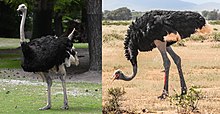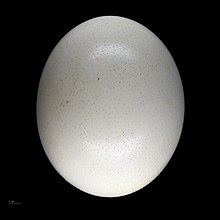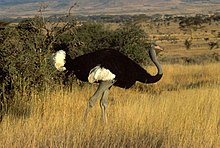Ostrich
| Ostrich | |
|---|---|

| |
| Montage of two living species, from left to right: common ostrich and Somali ostrich | |
| Scientific classification | |
| Kingdom: | Animalia |
| Phylum: | Chordata |
| Class: | Aves |
| Infraclass: | Palaeognathae |
| Order: | Struthioniformes |
| Family: | Struthionidae |
| Genus: | Struthio Linnaeus, 1758[1] |
| Type species | |
| Struthio camelus Linnaeus, 1758
| |
| Species | |
| |
| Synonyms | |
| |
Struthio is a genus of birds in the order Struthioniformes, whose members are the ostriches. It is part of the infra-class Palaeognathae, a diverse group of flightless birds also known as ratites that includes the emus, rheas, and kiwis. There are two living species of ostrich: the common ostrich and the Somali ostrich.[2] They are large flightless birds of Africa who lay the largest eggs of any living land animal. With the ability to run at 70 km/h (43.5 mph), they are the fastest birds on land. They are farmed worldwide, particularly for their feathers as they are used as decoration and feather dusters. Their skin is also used for leather products. Ostriches are notable for being the heaviest living birds.
Taxonomic history[]
The genus Struthio was first described by Carl Linnaeus in 1758. The genus was used by Linnaeus and other early taxonomists to include the emu, rhea, and cassowary, until they each were placed in their own genera.[1] The Somali ostrich (Struthio molybdophanes) has recently become recognized as a separate species by most authorities, while others are still reviewing the evidence.[3][4]
Evolution[]


The earliest fossils of ostrich-like birds are Paleocene taxa from Europe.[5] Palaeotis and Remiornis from the Middle Eocene and unspecified ratite remains are known from the Eocene and Oligocene of Europe and Africa. These may have been early relatives of the ostriches, but their status is questionable, and they may in fact represent multiple lineages of flightless paleognaths.[5][6]
The earliest fossils from this genus are from the early Miocene (20–25 mya) and are from Africa, so it is proposed that they originated there. Then by the middle to late Miocene (5–13 mya) they had spread to Eurasia.[7] By about 12 mya they had evolved into the larger size of which we are familiar. By this time they had spread to Mongolia and later southern Africa.[8] While the relationship of the African fossil species is comparatively straightforward, many Asian species of ostrich have been described from fragmentary remains, and their interrelationships and how they relate to the African ostriches are confusing. In China, ostriches are known to have become extinct only around or even after the end of the last ice age; images of ostriches have been found there on prehistoric pottery and petroglyphs.[9][10][11]
Struthio ostriches once co-existed with another lineage of flightless didactyl birds, the eogruids. Though Olson 1985 classified these birds as stem-ostriches, they until recently were universally considered to be related to cranes, any similarities being the result of convergent evolution. More recent analysis, however, has once again linked the ostriches to the eogruids.[12] Competition from ostriches has been suggested to have caused the extinction of the eogruids,[13][14] though this has never been tested and both groups do co-exist in some sites.[15]
Distribution and habitat[]

Today, ostriches are only found natively in the wild in Africa, where they occur in a range of open arid and semi-arid habitats such as savannas and the Sahel, both north and south of the equatorial forest zone.[16] The Somali ostrich occurs in the Horn of Africa, having evolved isolated from the common ostrich by the geographic barrier of the East African Rift. In some areas, the common ostrich's Masai subspecies occurs alongside the Somali ostrich, but they are kept from interbreeding by behavioral and ecological differences.[17] The Arabian ostriches in Asia Minor and Arabia were hunted to extinction by the middle of the 20th century, and in Israel attempts to introduce North African ostriches to fill their ecological role have failed.[18] Escaped common ostriches in Australia have established feral populations.[19][20][21]
Species[]
There are nine known species in this genus, of which seven are extinct.[contradictory] In 2008, S. linxiaensis was transferred to the genus Orientornis.[22] Three additional species, S. pannonicus, S. dmanisensis, and S. transcaucasicus, were transferred to the genus Pachystruthio in 2019.[23] Several additional fossil forms are ichnotaxa (that is, classified according to the organism's trace fossils such as footprints rather than its body) and their association with those described from distinctive bones is contentious and in need of revision pending more good material.[24]
The species are:
- Prehistoric
- † Arambourg 1979
- † Burchak-Abramovich 1939 (Pliocene of Ukraine)
- † (Brandt 1873) Lambrecht 1921 (Pliocene of SE Europe to WC Asia) – oospecies
- †Struthio coppensi Mourer-Chauviré et al. 1996 (Early Miocene of Elizabethfeld, Namibia)
- † Pickford, Senut & Dauphin 1995 (Early – Middle Pliocene of Namibia) – oospecies
- † Bonaparte 1856
- †Struthio kakesiensis Harrison & Msuya 2005 (Early Pliocene of Laetoli, Tanzania) – oospecies
- † Senut, Dauphin & Pickford 1998 (Late Miocene – Early Pliocene of SW and CE Africa) – oospecies(?)
- † Lowe 1933 (Late Pleistocene of Tanzania) – probably subspecies of S. camelus[25]
- †Struthio orlovi Kuročkin & Lungo 1970 (Late Miocene of Moldavia)
- †Struthio wimani Lowe 1931 (Early Pliocene of China and Mongolia)
- Late Pleistocene – Holocene
- † Lowe 1931, East Asian ostrich (Late Pleistocene of China to Mongolia)[10][26] – oospecies(?)
- †Struthio asiaticus Brodkorb 1863, Asian ostrich (Early Pliocene – Early Holocene of Central Asia to China? and Morocco)
- Struthio camelus, common ostrich
- Struthio molybdophanes, Somali ostrich
Footnotes[]
- ^ a b Gray, G.R. (1855)
- ^ "Seagull Publishers:: K-8 segment | Books | Practice manuals". Retrieved 2020-11-11.
- ^ Gil, F. & Donsker D. (2012)
- ^ Birdlife International (2012)
- ^ a b Buffetaut, E.; Angst, D. (2014). "Stratigraphic distribution of large flightless birds in the Palaeogene of Europe and its palaeobiological and palaeogeographical implications". Earth-Science Reviews. 138: 394–408. Bibcode:2014ESRv..138..394B. doi:10.1016/j.earscirev.2014.07.001.
- ^ Agnolin et al, Unexpected diversity of ratites (Aves, Palaeognathae) in the early Cenozoic of South America: palaeobiogeographical implications. Alcheringa An Australasian Journal of Palaeontology · July 2016 DOI: 10.1080/03115518.2016.1184898
- ^ Hou, L. et al. (2005)
- ^ Davies, S.J.J.F. (2003)
- ^ Doar, B.G. (2007) "Genitalia, Totems and Painted Pottery: New Ceramic Discoveries in Gansu and Surrounding Areas". China Heritage Quarterly
- ^ a b Janz, Lisa; et al. (2009). "Dating North Asian surface assemblages with ostrich eggshell: Implications for palaeoecology and extirpation". Journal of Archaeological Science. 36 (9): 1982–1989. doi:10.1016/j.jas.2009.05.012.
- ^ Andersson, J. G. (1923). "Essays on the cenozoic of northern China". Memoirs of the Geological Survey of China (Peking), Series A. 3: 1–152 (53–77).
- ^ Mayr, G. & Zelenkov, N. (2021) Extinct crane-like birds (Eogruidae and Ergilornithidae) from the Cenozoic of Central Asia are indeed ostrich precursors. Ornithology, https://doi.org/10.1093/ornithology/ukab048
- ^ Kurochkin, E.N. (1976). "A survey of the Paleogene birds of Asia". Smithsonian Contributions to Paleobiology. 27: 75–86.
- ^ Kurochkin, E.N. (1981). "New representatives and evolution of two archaic gruiform families in Eurasia". Transactions of the Soviet-Mongolian Paleontological Expedition. 15: 59–85.
- ^ Zelenkov, Nikita; Boev, Zlatozar; Lazaridis, Georgios (2015). "A large ergilornithine (Aves, Gruiformes) from the Late Miocene of the Balkan Peninsula". Paläontologische Zeitschrift. 90: 145–151. doi:10.1007/s12542-015-0279-z. S2CID 131264199.
- ^ Donegan, Keenan (2002). "Struthio camelus". Animal Diversity Web. University of Michigan Museum of Zoology.
- ^ Freitag, Stephanie & Robinson, Terence J. (1993). "Phylogeographic patterns in mitochondrial DNA of the Ostrich (Struthio camelus)" (PDF). The Auk. 110 (3): 614–622. doi:10.2307/4088425. JSTOR 4088425.
- ^ Rinat, Zafrir (25 December 2007). "The Bitter Fate of Ostriches in the Wild". Haaretz. Tel Aviv. Retrieved 10 January 2017.
- ^ Ostriches in Australia – and near my home. trevorsbirding.com (13 September 2007)
- ^ Rural, A. B. C. (2018-09-01). "The outback ostriches — Australia's loneliest birds". ABC News. Retrieved 2021-02-10.
- ^ "Common Ostrich (Struthio camelus)". iNaturalist Australia. Retrieved 2021-02-10.
- ^ Wang, S. (2008). "Rediscussion in the taxonomic assignment of "Struthio linxiaensis Hou, et al., 2005". Acta Paleotologica Sinica. 47: 362–368.
- ^ Zelenkov, N. V.; Lavrov, A. V.; Startsev, D. B.; Vislobokova, I. A.; Lopatin, A. V. (2019). "A giant early Pleistocene bird from eastern Europe: unexpected component of terrestrial faunas at the time of early Homo arrival". Journal of Vertebrate Paleontology. 39 (2): e1605521. doi:10.1080/02724634.2019.1605521. S2CID 198384367.
- ^ Bibi, Faysal; Shabel, Alan B.; Kraatz, Brian P.; Stidham, Thomas A. (2006). "New Fossil Ratite (Aves: Palaeognathae) Eggshell Discoveries from the Late Miocene Baynunah Foramation of the United Arab Emirates, Arabian Peninsula" (PDF). Palaeontologia Electronica. 9 (1): 2A. ISSN 1094-8074.
- ^ "OVPP-Struthio 8".
- ^ J. G. Andersson, Essays on the cenozoic of northern China. Memoirs of the Geological Survey of China (Peking), Series A, No. 3 (1923), pp. 1–152, especially pp. 53–77: "On the occurrence of fossil remains of Struthionidae in China."; and J. G. Andersson, Research into the prehistory of the Chinese. Bulletin of the Museum of Far Eastern Antiquities 15 (1943), 1–300, plus 200 plates.
References[]
- Andersson, Johan Gunnar (1923). On the occurrence of fossil remains of Struthionidae in China. In: Essays on the cenozoic of northern China. Memoirs of the Geological Survey of China (Peking), Series A, No. 3, pp. 53–77. Peking, China: Geological Survey of China.
- Andersson, Johan Gunnar (1943). "Researches into the prehistory of the Chinese". Bulletin of the Museum of Far Eastern Antiquities. 15: 1–300, plus 200 plates.
- BirdLife International (2012). "The BirdLife checklist of the birds of the world, with conservation status and taxonomic sources". Archived from the original (xls) on 25 December 2011. Retrieved 16 Jun 2012.
- Brands, Sheila (14 Aug 2008). "Taxon: Genus Struthio". Project: The Taxonomicon. Retrieved 12 Jun 2012.
- Davies, S. J. J. F. (2003). "Ostriches". In Hutchins, Michael (ed.). Birds I Tinamous and Ratites to Hoatzins. Grzimek's Animal Life Encyclopedia. 8 (2nd ed.). Farmington Hills, MI: Gale Group. p. 99. ISBN 978-0-7876-5784-0.
- Gill, F.; Donsker, D (2012). "Ratites". IOC World Bird List. WorldBirdNames.org. Retrieved 13 Jun 2012.
- Gray, George Robert (1855). Catalogue of the Genera and Subgenera of Birds contained in the British Museum. London, UK: Taylor and Francis. p. 109.
- Hou, L.; Zhou, Z.; Zhang, F.; Wang, Z. (Aug 2005). "A Miocene ostrich fossil from Gansu Province, northwest China". Chinese Science Bulletin. 50 (16): 1808–1810. Bibcode:2005ChSBu..50.1808H. doi:10.1360/982005-575. ISSN 1861-9541. S2CID 129449364.
- Janz, Lisa; et al. (2009). "Dating North Asian surface assemblages with ostrich eggshell: Implications for palaeoecology and extirpation". Journal of Archaeological Science. 36 (9): 1982–1989. doi:10.1016/j.jas.2009.05.012.
- "Seagull Publishers:: K-8 segment | Books | Practice manuals". Seagull Learning – A Unit of Seagull Publishers Private Limited. 7.
- Struthio
- Flightless birds
- Ratites
- Miocene birds
- Extant Miocene first appearances
- Taxa named by Carl Linnaeus



